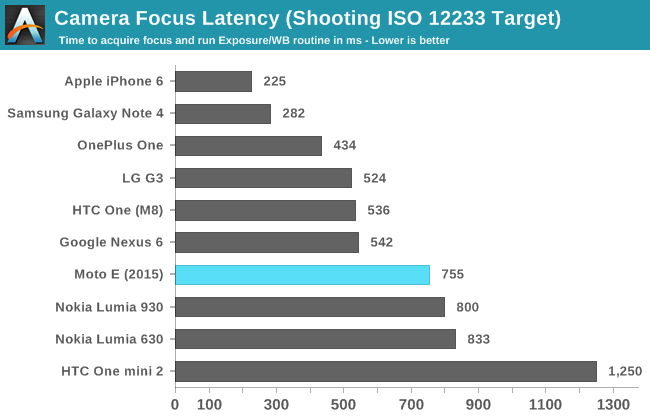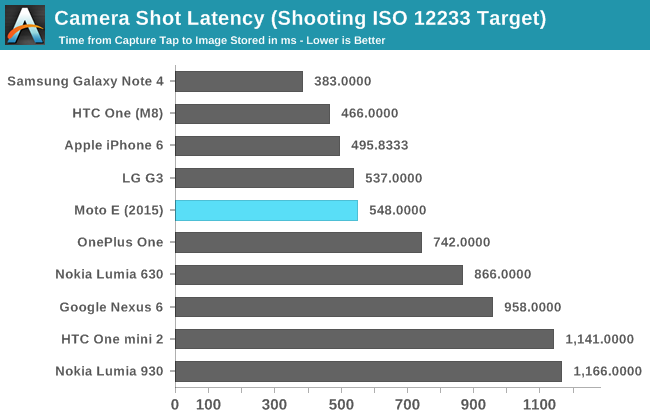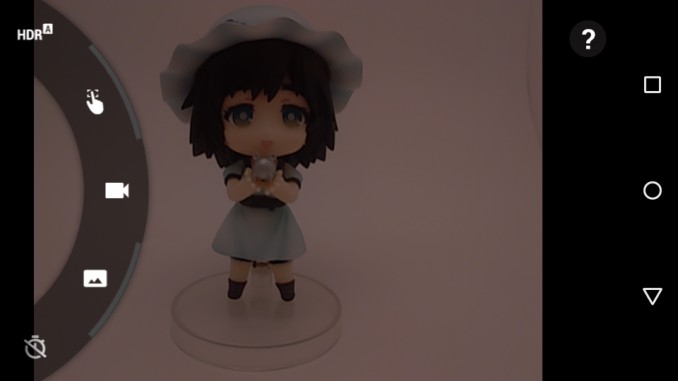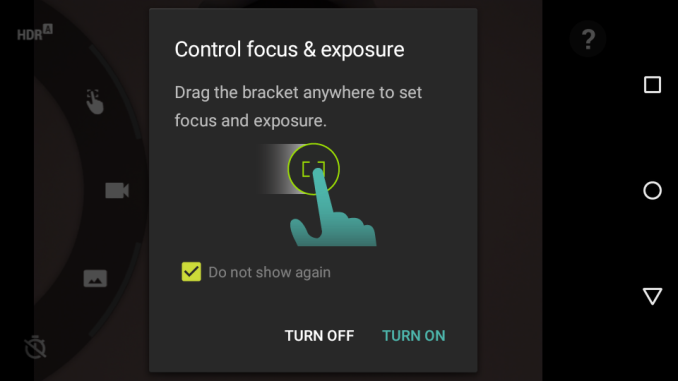The Moto E (2015) Review
by Brandon Chester on April 21, 2015 8:00 AM EST- Posted in
- Smartphones
- Motorola
- Mobile
- Moto E (2015)
Camera Architecture
It seems that having a camera is now a necessity on even the most inexpensive devices. But there are cases like HP's Stream 7 where the quality of the camera is so poor that you question whether it was even worth the money spent on it in the first place. However, with inexpensive smartphones the image quality is usually good enough for sharing via social media and instant messaging which makes it worth including. Whether or not this holds true for the Moto E is yet to be seen, but before discussing image quality it's important to have a good understanding of the Moto E's camera system.
| Motorola Moto E (2015) Camera Specifications | ||||
| Front Camera - Resolution | 0.3MP (640x480) | |||
| Front Camera - Sensor | Aptina MT9V113 (2.2µm, 1/11") |
|||
| Front Camera - Focal Length | 1.4mm | |||
| Front Camera - Max Aperture | F/3.0 | |||
| Rear Camera - Resolution | 5.0MP (2560x1920) | |||
| Rear Camera - Sensor | Samsung S5K5E2 (1.12µm, 1/5") | |||
| Rear Camera - Focal Length | 2.5mm (28mm eff) | |||
| Rear Camera - Max Aperture | F/2.2 | |||
The front facing camera on the Moto E is a 0.3MP sensor from Aptina. The original Moto E didn't even have a front facing camera so it's definitely an upgrade in that respect, but I do wonder if it would have been better to continue without the front facing camera and either spend the money elsewhere or further drive down the price of the phone.
The rear facing sensor is made by Samsung. It's a 1/5" 5MP sensor with 1.12 micron pixels. You may be familiar with it, as it was the sensor used for the HTC One M8's front-facing camera. It's also important to note that the 2015 Moto E supports autofocus, which is an enormous improvement over its predecessor which had a fixed focus camera. The video recording resolution of the rear camera has also been bumped from 854x480p30 to 1280x720p30.


The focus latency on the Moto E is one of the longer results on our test. For a device with only contrast detection auto focus it's not a bad result, although there are a couple devices that manage to focus a couple hundred milliseconds quicker. Shot latency is actually pretty good, and you don't ever feel like you're waiting in between taking photos.
Motorola Camera
Motorola includes their own camera application with the Moto E. By default it gives you what is essentially the most automatic camera experience possible, with zero control over focus, exposure, or any other options. In this mode, tapping anywhere on the display takes a photo, and the camera is always focused in the center. Pressing and holding on the display takes a succession of photos, which seems to work well apart from a pause after every 20 photos or so to write them to memory. Moving your finger up or down does a digital zoom up to 4.0x, although I wouldn't recommend it.
To access the controls in Motorola's camera app, you need to know to swipe in from the left side. I really don't like this hidden magic menu style of design. Motorola really should have had the menu set to be visible when the app is loaded and set it move off screen after a second or two. It is shown initially in the tutorial when you first run the app, but when you're relying on tutorials to show the user how to use the basic functions of your app your design is already a failure. Once you do find this menu, you'll be able to do various things like switch to panorama mode, change whether photos are stored on an SD card or internal memory, and most importantly, enable the control over focus and exposure that should have been enabled in the first place. You'll also be able to change the app from the default 3.7MP 16:9 cropped output to the full 2560x1920 output of the 4:3 sensor.
Unfortunately, even the focus control and exposure are implemented in a strange manner. You control the focus by moving a disk around on your screen, and when it turns green you know that you've successfully focused on that area. I understand what Motorola was trying to do here, as having the disk always on your screen lets you know where you focused. However, it's just not as intuitive as being able to tap somewhere to focus, and it just makes for a less comfortable experience than other camera applications.
I actually like some of Motorola's included applications, but the ones that try to replace the applications that already exist in AOSP or from Google tend to fall short. After playing with Motorola's camera app I just went to Google Play to download Google's Camera app which is quite frankly better than Motorola's. It's unfortunate though, because on an 8GB device the last thing you want is to have replacement apps for less than optimal default ones taking up space on your phone.
Of course, the biggest part of a smartphone's camera is not the camera app but the photos themselves. That's what I'll be looking at next.













90 Comments
View All Comments
zepi - Tuesday, April 21, 2015 - link
How much does a 1A or 2A rated charger drop the charging times?I think it is a bit silly to compare chargers instead of phones.
arnoudw - Tuesday, April 21, 2015 - link
Exactly. I reviewed the phone as well (the European version) and the one that's for sale on this side of the ocean hasn't got a charger at all in the box. I just used another charger that I have to charge the phone and charge times were pretty normal: around 2,5 hours from zero to full.AT would maybe consider a disclaimer that chargers can differ per country or region and that can infuence the outcome of this particular test immensely. AT has got a worldwide audience and a lot of the potential buyers of this phone reading the review here might be from another part of the world. That's something for AT to consider, I guess.
TLDR; tested it as well, there was no charger included, charges normally with another charger.
sovking - Tuesday, April 21, 2015 - link
I agree. Charge time comparison should be done with the same charger or better with 2 or 3 chargers.Chargers for smarphone are universal, all devices connect to micro-usb chargers with 5V. At home we have more chargers for more smartphone and we do not matter which charger we are using.
So create a table showing a charging time when using 0.5A, 1A charger, 2A charger.
Some smartphone like Moto G 2014, limit input current, so it worth using until 1.5 A charger, more current is not used.
Ryan Smith - Tuesday, April 21, 2015 - link
To be clear here, the purpose is to test the charge time of the phone in its default configuration. It's not to compare just the chargers, but the entire package.hans_ober - Tuesday, April 21, 2015 - link
You've got a point; anyone who is buying this as their first Android (upgrading from an old Nokia), will most probably use the included charger and it was right to include the charge time using the 'package' the user would most probably use. However, since this is a case where the charger is to blame for the slow charging speeds, it would have been useful to include another result with another high powered charger, which would confirm that the phone IS capable of higher charging speeds if another charger is used and how much time could probably be saved by using a high powered charger.hans_ober - Wednesday, April 29, 2015 - link
Do you have a Quick charge 2.0 charger? The Motorola Turbo Charger? Just curious to see whether it works, because iirc QC 2.0 support was mentioned somewhere.victorson - Tuesday, April 21, 2015 - link
There is a mistake, the Moto E is not $109, it's actually $120 for the slow Snapdragon 200 version, and a not-so-cheap $150 for the Snadpragon 400 version. It's funny how the author can't think of competition when you have devices from Xiaomi and Meizu (among tens if not hundred others) that deliver better value for the money.close - Tuesday, April 21, 2015 - link
In EU the Moto E LTE is ~130E while the cheapest Xiaomi starts at ~170E. I wouldn't think twice.Brandon Chester - Tuesday, April 21, 2015 - link
The number of markets that you can purchase Xiaomi phones in is extremely small, you can count them on one hand. Also I apologize about the pricing error. There have been a few sales on it recently and for whatever reason I noted the price as $109. That being said, it does drop below Motorola's price very often. For example, it's currently available in India on Flipkart for $127 USD. India does happen to be an Xiaomi market and so I would definitely urge buyers there to check out their devices as well. But that's not an option for most buyers.victorson - Tuesday, April 21, 2015 - link
Thanks for the reply, Brandon! I agree that you can get the phone cheaper on sales and I wouldn't argue against the Moto E being an overall good value for the money, but it's also true that you can buy said Xiaomi phones (or many others for that matter, I don't want this to sound like an ad) from retailers like Pandawill.com, Coolicool.com, or others that ship internationally for free. And the user who said that Xiaomi starts at 170 euro, may want to pay a visit and see that prices on those sites start at around $120, not 170 euro.